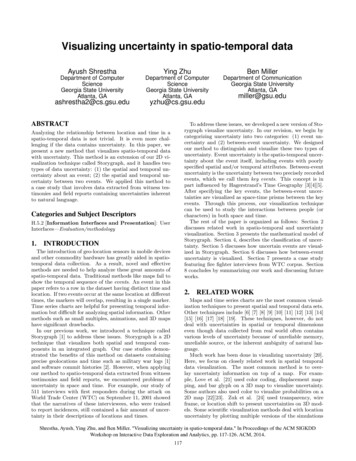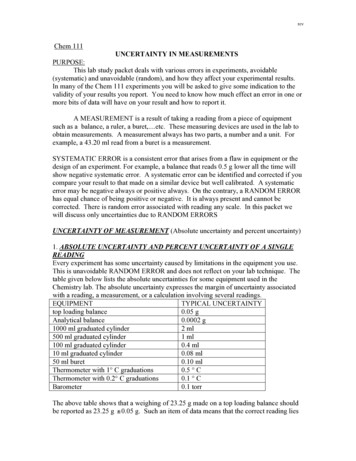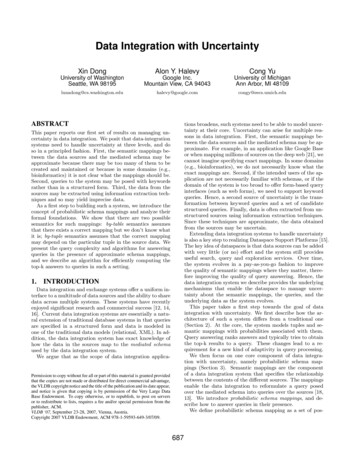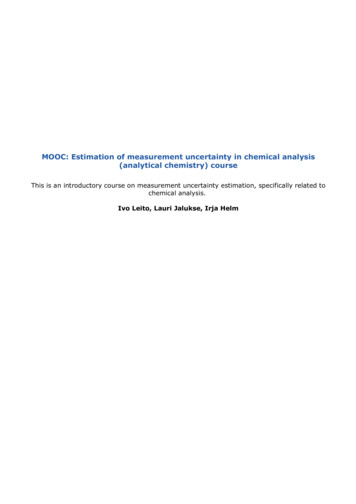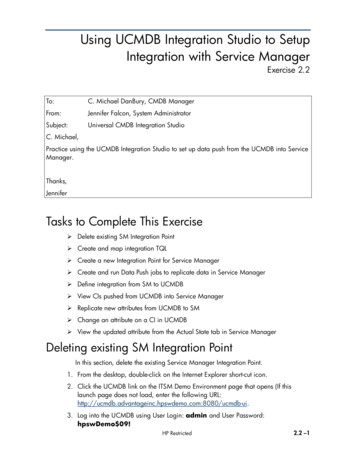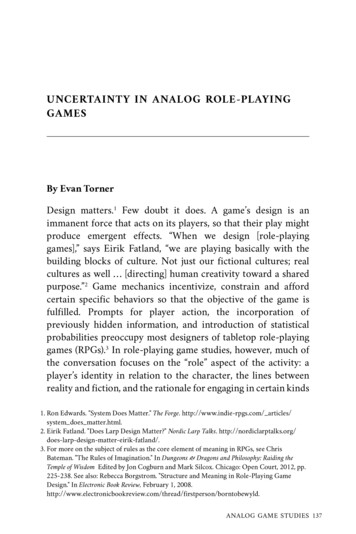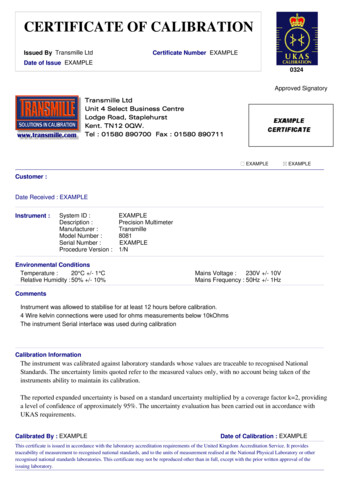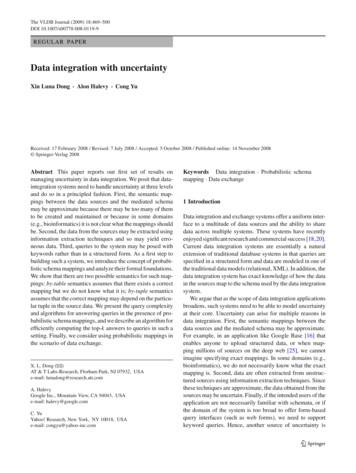
Transcription
The VLDB Journal (2009) 18:469–500DOI 10.1007/s00778-008-0119-9REGULAR PAPERData integration with uncertaintyXin Luna Dong · Alon Halevy · Cong YuReceived: 17 February 2008 / Revised: 7 July 2008 / Accepted: 5 October 2008 / Published online: 14 November 2008 Springer-Verlag 2008Abstract This paper reports our first set of results onmanaging uncertainty in data integration. We posit that dataintegration systems need to handle uncertainty at three levelsand do so in a principled fashion. First, the semantic mappings between the data sources and the mediated schemamay be approximate because there may be too many of themto be created and maintained or because in some domains(e.g., bioinformatics) it is not clear what the mappings shouldbe. Second, the data from the sources may be extracted usinginformation extraction techniques and so may yield erroneous data. Third, queries to the system may be posed withkeywords rather than in a structured form. As a first step tobuilding such a system, we introduce the concept of probabilistic schema mappings and analyze their formal foundations.We show that there are two possible semantics for such mappings: by-table semantics assumes that there exists a correctmapping but we do not know what it is; by-tuple semanticsassumes that the correct mapping may depend on the particular tuple in the source data. We present the query complexityand algorithms for answering queries in the presence of probabilistic schema mappings, and we describe an algorithm forefficiently computing the top-k answers to queries in such asetting. Finally, we consider using probabilistic mappings inthe scenario of data exchange.X. L. Dong (B)AT & T Labs-Research, Florham Park, NJ 07932, USAe-mail: lunadong@research.att.comA. HalevyGoogle Inc., Mountain View, CA 94043, USAe-mail: halevy@google.comC. YuYahoo! Research, New York, NY 10018, USAe-mail: congyu@yahoo-inc.comKeywords Data integration · Probabilistic schemamapping · Data exchange1 IntroductionData integration and exchange systems offer a uniform interface to a multitude of data sources and the ability to sharedata across multiple systems. These systems have recentlyenjoyed significant research and commercial success [18,20].Current data integration systems are essentially a naturalextension of traditional database systems in that queries arespecified in a structured form and data are modeled in one ofthe traditional data models (relational, XML). In addition, thedata integration system has exact knowledge of how the datain the sources map to the schema used by the data integrationsystem.We argue that as the scope of data integration applicationsbroadens, such systems need to be able to model uncertaintyat their core. Uncertainty can arise for multiple reasons indata integration. First, the semantic mappings between thedata sources and the mediated schema may be approximate.For example, in an application like Google Base [16] thatenables anyone to upload structured data, or when mapping millions of sources on the deep web [25], we cannotimagine specifying exact mappings. In some domains (e.g.,bioinformatics), we do not necessarily know what the exactmapping is. Second, data are often extracted from unstructured sources using information extraction techniques. Sincethese techniques are approximate, the data obtained from thesources may be uncertain. Finally, if the intended users of theapplication are not necessarily familiar with schemata, or ifthe domain of the system is too broad to offer form-basedquery interfaces (such as web forms), we need to supportkeyword queries. Hence, another source of uncertainty is123
470the transformation between keyword queries and a set ofcandidate structured queries.Dataspace Support Platforms [19] envision data integration systems where sources are added with no effort and thesystem is constantly evolving in a pay-as-you-go fashion toimprove the quality of semantic mappings and query answering. Enabling data integration with uncertainty is a keytechnology to supporting dataspaces.This paper takes a first step towards the goal of data integration with uncertainty. We first describe how the architecture of such a system differs from a traditional one (Sect. 2).At the core, the system models tuples and semantic mappingswith probabilities associated with them. Query answeringranks answers and typically tries to obtain the top-k resultsto a query. These changes lead to a requirement for a newkind of adaptivity in query processing.We then focus on one core component of data integration with uncertainty, namely probabilistic schema mappings(Sect. 3). Semantic mappings are the component of a dataintegration system that specify the relationship between thecontents of the different sources. The mappings enable thedata integration to reformulate a query posed over the mediated schema into queries over the sources [17,22]. We introduce probabilistic schema mappings, and describe how toanswer queries in their presence.We define probabilistic schema mapping as a set of possible (ordinary) mappings between a source schema and atarget schema, where each possible mapping has an associated probability. We begin by considering a simple classof mappings, where each mapping describes a set of correspondences between the attributes of a source table and theattributes of a target table. We argue that there are two possible interpretations of probabilistic schema mappings. In thefirst, which we formalize as by-table semantics, we assumethere exists a single correct mapping between the source andthe target, but we do not know which one it is. In the second,called by-tuple semantics, the correct mapping may dependon the particular tuple in the source to which it is applied. Inboth cases, the semantics of query answers are a generalization of certain answers [1] for data integration systems.We describe algorithms for answering queries in the presence of probabilistic schema mappings and then analyze thecomputational complexity of answering queries (Sect. 4). Weshow that the data complexity of answering queries in thepresence of probabilistic mappings is PTIME for by-tablesemantics and #P-complete for by-tuple semantics. We identify a large subclass of real-world queries for which we canstill obtain all the by-tuple answers in PTIME. We then describe algorithms for finding the top-k answers to a query(Sect. 5).The size of a probabilistic mapping may be quite large,since it essentially enumerates a probability distribution bylisting every combination of events in the probability space.123X. L. Dong et al.In practice, we can often encode the same probabilitydistribution much more concisely. Our next contribution(Sect. 6) is to identify two concise representations of probabilistic mappings for which query answering can be performedin PTIME in the size of the mapping. We also examine thepossibility of representing a probabilistic mapping as a BayesNet, but show that query answering may still be exponentialin the size of a Bayes Net representation of a mapping.We then consider using probabilistic mappings in the scenario of data exchange (Sect. 7), where the goal is to createan instance of the target schema that is consistent with thedata in the sources. We show that we can create a probabilisticdatabase representing a core universal solution in polynomialtime. As in the case of non-probabilistic mappings, the coreuniversal solution can be used to find all the answers to a givenquery. This section also shows the close relationship betweenprobabilistic databases and probabilistic schema mappings.In addition, we study some of the basic properties of probabilistic schema mappings: mapping composition and inversion(Sect. 8).Finally, we consider several more powerful mapping languages, such as complex mappings, where the correspondences are between sets of attributes, and conditionalmappings, where the mapping is conditioned on a propertyof the tuple to which it is applied (Sect. 9).This article is an extended version of a previous conferencepaper [9]. The material in Sects. 7 and 8 is new, as are theproofs of all the formal results. As follow-up work, we describe in [32] how to create probabilistic mappings and builda self-configuring data integration system. In [32] we havealso reported experimental results on real-world data setscollected from the Web, showing that applying a probabilistic model in data integration enables producing high-qualityquery answers with no human intervention.2 Overview of the systemThis section describes the requirements from a data integration system that supports uncertainty and the overall architecture of the system. We frame our specific contributions inthe context of this architecture.2.1 Uncertainty in data integrationA data integration system needs to handle uncertainty at threelevels:Uncertain schema mappings. Data integration systems relyon schema mappings for specifying the semantic relationships between the data in the sources and the terms usedin the mediated schema. However, schema mappings can beinaccurate. In many applications it is impossible to createand maintain precise mappings between data sources. This
Data integration with uncertainty471can be because the users are not skilled enough to provideprecise mappings, such as in personal information management [8], because people do not understand the domain welland thus do not even know what correct mappings are, suchas in bioinformatics, or because the scale of the data preventsgenerating and maintaining precise mappings, such as in integrating data of the web scale [25]. Hence, in practice, schemamappings are often generated by semi-automatic tools andnot necessarily verified by domain experts.Uncertain data. By nature, data integration systems needto handle uncertain data. One reason for uncertainty is thatdata are often extracted from unstructured or semi-structuredsources by automatic methods (e.g., HTML pages, emails,blogs). A second reason is that data may come from sourcesthat are unreliable or not up to date. For example, in enterprisesettings, it is common for informational data such as gender,racial, and income level to be dirty or missing, even whenthe transactional data is precise.Uncertain queries. In some data integration applications,especially on the web, queries will be posed as keywordsrather than as structured queries against a well definedschema. The system needs to translate these queries into somestructured form so they can be reformulated with respect tothe data sources. At this step, the system may generate multiple candidate structured queries and have some uncertaintyabout which is the real intent of the user.2.2 System architectureGiven the previously discussed requirements, we describethe architecture of a data integration system that managesuncertainty at its core. We describe the system by contrastingit to a traditional data integration system.The first and most fundamental characteristic of thissystem is that it is based on a probabilistic data model. Thischaracteristic means two things. First, as we process data inthe system we attach probabilities to each tuple. Second, andthe focus of this paper, we associate schema mappings withprobabilities, modeling the uncertainty about the correctnessof the mappings. We use these probabilities to rank answers.Second, whereas traditional data integration systems beginby reformulating a query onto the schemas of the data sources,a data integration system with uncertainty needs to first reformulate a keyword query into a set of candidate structuredqueries. We refer to this step as keyword reformulation. Notethat keyword reformulation is different from techniques forkeyword search on structured data (e.g., [2,21]) in that (a) itdoes not assume access to all the data in the sources or thatthe sources support keyword search, and (b) it tries to distinguish different structural elements in the query in order topose more precise queries to the sources (e.g., realizing that inQKeywordReformulationMediated SchemaQ 1,.Q mQueryReformulationQ 11,.Q 1n, ,Qk1,.Q knQueryPocessorQ 11,.Q 1n.Q k1,.Q knDkD1D4D2D3Fig. 1 Architecture of a data-integration system that handles uncertaintythe keyword query “Chicago weather”, “weather” is an attribute label and “Chicago” is an instance name). That beingsaid, keyword reformulation should benefit from techniquesthat support answering keyword search on structured data.Third, the query answering model is different. Instead ofnecessarily finding all answers to a given query, our goal istypically to find the top-k answers, and rank these answersmost effectively.The final difference from traditional data integration systems is that our query processing will need to be more adaptive than usual. Instead of generating a query answering planand executing it, the steps we take in query processing willdepend on results of previous steps. We note that adaptivequery processing has been discussed quite a bit in data integration [23], where the need for adaptivity arises from thefact that data sources did not answer as quickly as expectedor that we did not have accurate statistics about their contentsto properly order our operations. In our work, however, thegoal for adaptivity is to get the answers with high probabilities faster.The architecture of the system is shown in Fig. 1. Thesystem contains a number of data sources and a mediatedschema. When the user poses a query Q, which can be eithera structured query on the mediated schema or a keywordquery, the system returns a set of answer tuples, each with aprobability. If Q is a keyword query, the system first performskeyword reformulation to translate it into a set of candidatestructured queries on the mediated schema. Otherwise, thecandidate query is Q itself.Consider how the system answers the candidate queries,and assume the queries will not involve joins over multiple sources. For each candidate structured query Q 0 anda data source S, the system reformulates Q 0 according tothe schema mapping (which can be uncertain) between S’s123
472X. L. Dong et al.Fig. 2 The running example: aa probabilistic schema mappingbetween S and T ; b a sourceinstance D S ; c the answers of Qover D S with respect to theprobabilistic mapping(a)(b)(c)schema and the mediated schema, sends the reformulatedquery (or queries) to S, retrieving the answers.If the user asks for all the answers to the query, then thereformulated query is typically a query with grouping andaggregation, because the semantics of answers require aggregating the probabilities of answers from multiple sources. IfS does not support grouping or aggregation, then groupingand aggregation needs be processed in the integration system.If the user asks for top-k answers, then query processingis more complex. The system reformulates the query intoa set of queries, uses a middle layer to decide at runtimewhich queries are critical to computing the top-k answers,and sends the appropriate queries to S. Note that we mayneed several iterations, where in each iteration we decidewhich are the promising reformulated queries to issue, andthen retrieving answers. Furthermore, the system can evendecide which data sources are more relevant and prioritizethe queries to those data sources. Finally, if the data in thesources are uncertain, then the sources will return answerswith probabilities attached to them.After receiving answers from different data sources, thesystem combines them to get one single set of answer tuples.For example, if the data sources are known to be independentof each other, and we obtain tuple t from n data sourceswith probabilities p1 , . . . , pn , respectively, then in the finaln (1 p ). If we knowanswer set t has probability 1 i 1ithat some data sources are duplicates or extensions of others,a different combination function needs to be used.Before the formal discussion, we illustrate the main ideaswith an example.2.3 Handling uncertainty in mappingsQ1: SELECT current-addr FROM SQ2: SELECT permanent-addr FROM SQ3: SELECT email-addr FROM SAs a first step towards developing such a data integration system, we introduce in this paper probabilistic schema mappings, and show how to answer queries in their presence.123Example 1 Consider a data source S, which describes aperson by her email address, current address, and permanent address, and the mediated schema T , which describesa person by her name, email, mailing address, home addressand office address:S (pname, email-addr, current-addr,permanent-addr)T (name, email, mailing-addr, home-addr,office-addr)A semi-automatic schema-mapping tool may generatethree possible mappings between S and T , assigning eacha probability. Whereas the three mappings all map pnameto name, they map other attributes in the source and the targetdifferently. Figure 2a describes the three mappings using setsof attribute correspondences. For example, mapping m 1 mapspname to name, email-addr to email, current-addr tomailing-addr, and permanent-addr to home-addr. Because of the uncertainty about which mapping is correct, weconsider all of these mappings in query answering.Suppose the system receives a query Q formulated usingthe mediated schema and asking for people’s mailingaddresses:Q: SELECT mailing-addr FROM TUsing the possible mappings, we can reformulate Q intodifferent queries:If the user requires all possible answers, the system generates a single aggregation query based on Q 1 , Q 2 and Q 3 to
Data integration with uncertaintycompute the probability of each returned tuple, and sends thequery to the data source. Suppose the data source contains atable D S as shown in Fig. 2b, the system will retrieve fouranswer tuples, each with a probability, as shown in Fig. 2c.If the user requires only the top-1 answer (i.e., the answer tuple with the highest probability), the system decides atruntime which reformulated queries to execute. For example,after executing Q 1 and Q 2 at the source, the system canalready conclude that (‘Sunnyvale’) is the top-1 answer andcan skip query Q 3 .2.4 Source of probabilitiesA critical issue in any system that manages uncertainty iswhether we have a reliable source of probabilities. Whereasobtaining reliable probabilities for such a system is one ofthe most interesting areas for future research, there is quitea bit to build on. For keyword reformulation, it is possibleto train and test reformulators on large numbers of queries such that each reformulation result is given a probability based on its performance statistics. For informationextraction, current techniques are often based on statisticalmachine learning methods and can be extended to computeprobabilities of each extraction result. Finally, in the case ofschema matching, it is standard practice for schema matchersto also associate numbers with the candidates they propose.The issue here is that the numbers are meant only as a ranking mechanism rather than true probabilities. However, asschema matching techniques start looking at a larger number of schemas, one can imagine ascribing probabilities (orestimations thereof) to their measures. Techniques on generating probabilistic mappings from schema matching resultsare presented in [32].3 Probabilistic schema mappingIn this section we formally define the semantics of probabilistic schema mappings and the query answering problemswe consider. Our discussion is in the context of the relational data model. A schema contains a finite set of relations.Each relation contains a finite set of attributes and is denotedby R r1 , . . . , rn . An instance D R of R is a finite set oftuples, where each tuple associates a value with each attributein the schema.We consider select-project-join (SPJ) queries in SQL.Note that answering such queries is in PTIME in the sizeof the data.3.1 Schema mappingsWe begin by reviewing non-probabilistic schema mappings.The goal of a schema mapping is to specify the semanticrelationships between a source schema and a target schema.473We refer to the source schema as S̄, and a relation in S̄ asS s1 , . . . , sm . Similarly, we refer to the target schema asT̄ , and a relation in T̄ as T t1 , . . . , tn .We consider a limited form of schema mappings that arealso referred to as schema matching in the literature [30].Specifically, a schema matching contains a set of attributecorrespondences. An attribute correspondence is of the formci j (si , t j ), where si is a source attribute in the schemaS and t j is a target attribute in the schema T . Intuitively,ci j specifies that there is a relationship between si and t j .In practice, a correspondence also involves a function thattransforms the value of si to the value of t j . For example, thecorrespondence (c-degree, temperature) can be specifiedas temperature c-degree 1.8 32, describing a transformation from Celsius to Fahrenheit. These functions areirrelevant to our discussion, and therefore we omit them. Weconsider this class of mappings because they already exposemany of the novel issues involved in probabilistic mappingsand because they are quite common in practice. We also notethat many of the concepts we define apply to a broader classof mappings, which we will discuss in detail in Sect. 4.1.Formally, we define relation mappings and schema mappings as follows.Definition 1 (Schema mapping) Let S̄ and T̄ be relationalschemas. A relation mapping M is a triple (S, T, m), whereS is a relation in S̄, T is a relation in T̄ , and m is a set ofattribute correspondences between S and T .When each source and target attribute occurs in at mostone correspondence in m, we call M a one-to-one relationmapping.A schema mapping M is a set of one-to-one relation mappings between relations in S̄ and in T̄ , where every relationin either S̄ or T̄ appears at most once.A pair of instances D S and DT satisfies a relation mappingm if for every source tuple ts D S , there exists a targettuple tt Dt , such that for every attribute correspondence(s, t) m, the value of attribute s in ts is the same as thevalue of attribute t in tt .Example 2 Consider the mappings in Example 1. The sourcedatabase in Fig. 2b (repeated in Fig. 3a) and the target database in Fig. 3b satisfy m 1 .3.2 Probabilistic schema mappingsIntuitively, a probabilistic schema mapping describes a probability distribution of a set of possible schema mappingsbetween a source schema and a target schema.Definition 2 (Probabilistic mapping) Let S̄ and T̄ be relational schemas. A probabilistic mapping (p-mapping), pM,is a triple (S, T, m), where S S̄, T T̄ , and m is a set{(m 1 , Pr(m 1 )), . . . , (m l , Pr(m l ))}, such that123
474X. L. Dong et al.Fig. 3 Example 3 a a sourceinstance D S ; b a target instancethat is by-table consistent withD S and m 1 ; c a target instancethat is by-tuple consistent withD S and m 2 , m 3 ; dQ table (D S ); e Q tuple (D S )(a)(b)(c)(d)– for i [1, l], m i is a one-to-one mapping between S andT , and for every i, j [1, l], i j m i m j . – Pr(m i ) [0, 1] and li 1 Pr(m i ) 1.A schema p-mapping, pM, is a set of p-mappings betweenrelations in S̄ and in T̄ , where every relation in either S̄ or T̄appears in at most one p-mapping.We refer to a non-probabilistic mapping as an ordinarymapping. A schema p-mapping may contain both p-mappingsand ordinary mappings. Example 1 shows a p-mapping (seeFig. 2a) that contains three possible mappings.3.3 Semantics of probabilistic mappingsIntuitively, a probabilistic schema mapping models the uncertainty about which of the mappings in pM is the correct one.When a schema matching system produces a set of candidatematches, there are two ways to interpret the uncertainty: (1)a single mapping in pM is the correct one and it applies toall the data in S, or (2) several mappings are partially correct and each is suitable for a subset of tuples in S, thoughit is not known which mapping is the right one for a specifictuple. Example 1 illustrates the first interpretation and queryrewriting under this interpretation. For the same example,the second interpretation is equally valid: some people maychoose to use their current address as mailing address whileothers use their permanent address as mailing address; thus,for different tuples we may apply different mappings, so thecorrect mapping depends on the particular tuple.This paper analyzes query answering under both interpretations. We refer to the first interpretation as the by-tablesemantics and to the second one as the by-tuple semantics ofprobabilistic mappings. We are not trying to argue for one123(e)interpretation over the other. The needs of the applicationshould dictate the appropriate semantics. Furthermore, ourcomplexity results, which will show advantages to by-tablesemantics, should not be taken as an argument in the favorof by-table semantics.We next define query answering with respect to pmappings in detail and the definitions for schema p-mappingsare the obvious extensions. Recall that given a query and anordinary mapping, we can compute certain answers to thequery with respect to the mapping. Query answering withrespect to p-mappings is defined as a natural extension ofcertain answers, which we next review.A mapping defines a relationship between instances of Sand instances of T that are consistent with the mapping.Definition 3 (Consistent target instance) Let M (S, T, m)be a relation mapping and D S be an instance of S.An instance DT of T is said to be consistent with D S andM, if for each tuple ts D S , there exists a tuple tt DT ,such that for every attribute correspondence (as , at ) m,the value of as in ts is the same as the value of at in tt .For a relation mapping M and a source instance D S ,there can be an infinite number of target instances that areconsistent with D S and M. We denote by Tar M (D S ) the setof all such target instances. The set of answers to a query Q isthe intersection of the answers on all instances in Tar M (D S ).The following definition is from [1].Definition 4 (Certain answer) Let M (S, T, m) be a relation mapping. Let Q be a query over T and let D S be aninstance of S.A tuple t is said to be a certain answer of Q with respectto D S and M, if for every instance DT Tar M (D S ), t Q(DT ).
Data integration with uncertaintyBy-table semantics. We now generalize these notions to theprobabilistic setting, beginning with the by-table semantics.Intuitively, a p-mapping pM describes a set of possibleworlds, each with a possible mapping m pM. In bytable semantics, a source table can fall in one of the possibleworlds; that is, the possible mapping associated with thatpossible world applies to the whole source table. Followingthis intuition, we define target instances that are consistentwith the source instance.Definition 5 (By-table consistent instance) Let pM (S,T, m) be a p-mapping and D S be an instance of S.An instance DT of T is said to be by-table consistent withD S and pM, if there exists a mapping m m such that D Sand DT satisfy m.Given a source instance D S and a possible mapping m m, there can be an infinite number of target instances that areconsistent with D S and m. We denote by Tar m (D S ) the setof all such instances.In the probabilistic context, we assign a probability toevery answer. Intuitively, we consider the certain answerswith respect to each possible mapping in isolation. The probability of an answer t is the sum of the probabilities of themappings for which t is deemed to be a certain answer. Wedefine by-table answers as follows:Definition 6 (By-table answer) Let pM (S, T, m) be ap-mapping. Let Q be a query over T and let D S be an instanceof S.Let t be a tuple. Let m̄(t) be the subset of m, such that foreach m m̄(t) and for each DT Tar m (D S ), t Q(DT ). Let p m m̄(t) Pr(m). If p 0, then we say (t, p) isa by-table answer of Q with respect to D S and pM.By-tuple semantics. If we follow the possible-world notions,in by-tuple semantics, different tuples in a source table canfall in different possible worlds; that is, different possiblemappings associated with those possible worlds can apply tothe different source tuples.Formally, the key difference in the definition of by-tuplesemantics from that of by-table semantics is that a consistenttarget instance is defined by a mapping sequence that assignsa (possibly different) mapping in m to each source tuple inD S . (Without losing generality, in order to compare betweensuch sequences, we assign some order to the tuples in theinstance).Definition 7 (By-tuple consistent instance) Let pM (S,T, m) be a p-mapping and let D S be an instance of S with dtuples.An instance DT of T is said to be by-tuple consistent withD S and pM, if there is a sequence m 1 , . . . , m d , where d isthe number of tuples in D S , and for every 1 i d,475– m i m, and– for the i th tuple of D S , ti , there exists a target tuple ti DT such that for each attribute correspondence (as , at ) m i , the value of as in ti is the same as the value of atin ti .Given a mapping sequence seq m 1 , . . . , m d , wedenote by Tar seq (D S ) the set of all target instances thatare consistent with D S and seq. Note that if DT is by-tableconsistent with D S and m, then DT is also by-tuple consistentwith D S and a mapping sequence in which each mappingis m.We can think of every sequence of mappings seq m 1 , . . . , m d as a separate event whose probability isd Pr(m i ). (In Sect. 9 we relax this indepenPr(seq) i 1dence assumption and introduce conditional mappings.) Ifthere are l mappings in pM, then there are l d sequences oflength d, and their probabilities add up to 1. We denote byseqd ( pM) the set of mapping sequences of length d generated from pM.Definition 8 (By-tuple answer) Let pM (S, T, m) be ap-mapping. Let Q be a query over T and D S be an instanceof S with d tuples.Let t be a tuple. Let seq(t) be the sub
data integration system has exact knowledge of how the data in the sources map to the schema used by the data integration system. We argue that as the scope of data integration applications broadens, such systems need to be able to model uncertainty at their core. Uncertainty can arise for multiple reasons in data integration.
